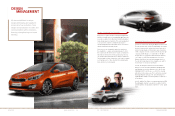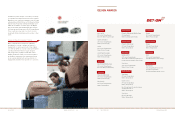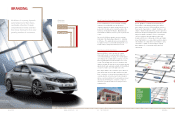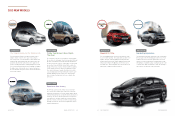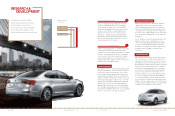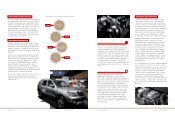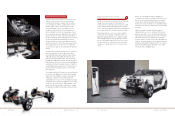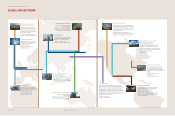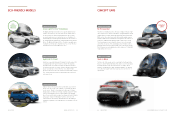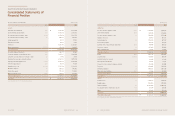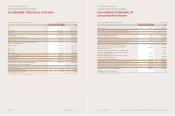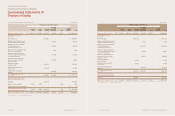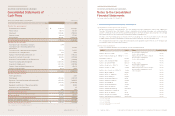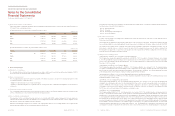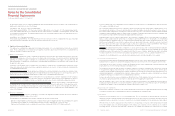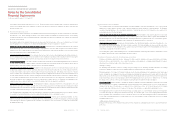Kia 2013 Annual Report Download - page 30
Download and view the complete annual report
Please find page 30 of the 2013 Kia annual report below. You can navigate through the pages in the report by either clicking on the pages listed below, or by using the keyword search tool below to find specific information within the annual report.
In Europe, diesel cars account for more than 50% of all
vehicles on the road. In the U.S., the diesel market is
expanding, with growing recognition of diesel vehicles
as eco-friendly cars, which is a change in the previous
negative image of diesel cars. Korea is also seeing
increased demand for diesel cars, thanks to the eco-
friendliness of diesel engines. The new generation of
diesels maintains the classic diesel advantage of good
fuel economy but generates significantly fewer emissions,
which is why they are called ‘clean diesels’. Kia Motors’
U2 diesel engine for city cars and R and S2 diesel engines
for RVs employ CRDi (Common Rail Direct injection)
technology, which involves precision, high-pressure fuel
injection via electronic control. Vehicles powered by these
diesel engines have 20-30% better fuel economy and
around 20% lower CO2 emissions than gasoline-powered
vehicles.
The atmospheric pollutants generated in fuel combustion
have been a problem for diesels, which emit carbon
monoxide (CO), hydrocarbons (HC), particulate matters
(PM), and nitrogen oxides (NOx). Among them, more
than 90% of CO, HC, and PM can be removed through
the DOC (Diesel Oxidation Catalysts) and the DPF (Diesel
Particulate Filter). In Europe, emissions of PM and NOx are
regulated by the Euro-V standards, and Euro-VI with 56%
tougher NOx restrictions will go into effect in 2014. Korea
has strict emission regulations in place, modeled after
those in Europe.
To treat NOx, which the DPF cannot filter, we developed the
LP (Low Pressure) EGR System and the LNT (Lean NOx
Trap) in 2012. The LP EGR re-circulates and combusts
exhaust gases that have not been fully combusted,
cutting NOx emissions by over 60% and improving engine
combustion efficiency which also enhances fuel economy.
In July 2012, we launched the LP EGR-equipped Sorento,
which meets Euro-VI standards, and we plan to expand
the application of EGR to the Sportage and other models.
We also use aerodynamic designs to minimize fuel
consumption caused by air resistance and surface friction.
We also use tires with low rolling resistance to minimize
surface friction. The 2012 Cerato/Forte (K3) has a drag
resistance of only 0.27 cd thanks to its streamlined design,
and features low friction tires which have 10% lower rolling
resistance.
ISG (Idle Stop & Go) automatically shuts down the
engine when the car comes to a halt and then restarts it
when the car begins to move, thus minimizing idling and
improving fuel economy by around 10%. We offer manual
transmission ISG in the cee’d and Venga, our flagship
models in Europe, as well as in the Picanto (Morning) and
Sportage. In the Korean market, we first applied automatic
transmission ISG and CVT ISG in the 2011 Forte, followed
by the Picanto (Morning), Ray, Rio (Pride), Soul, all-new
Forte/Cerato (K3), and Optima (K5).
Kia Motors has developed a gear-free CVT (Continuously
Variable Transmission), which results in better fuel
economy, and it is now being used selectively on certain
models. We have applied the Kappa CVT, developed in
2012, to the Picanto (Morning) and the Ray, enhancing fuel
economy by around 5-6% over that of previous models.
Another important factor for fuel economy is a lighter
vehicle body. We are making considerable efforts to go
lightweight, applying lighter yet more durable materials
and changing molding techniques. We plan to expand
the use of ultra-high strength steel from 20% in our mid-
size line-up in 2012 to at least 50% by 2015, which will
contribute to a weight reduction of over 10 kg for each
vehicle.


